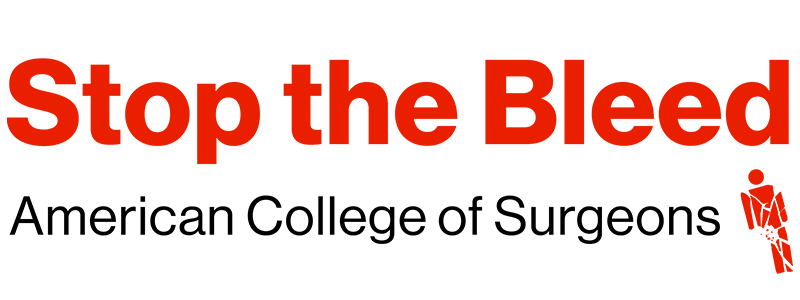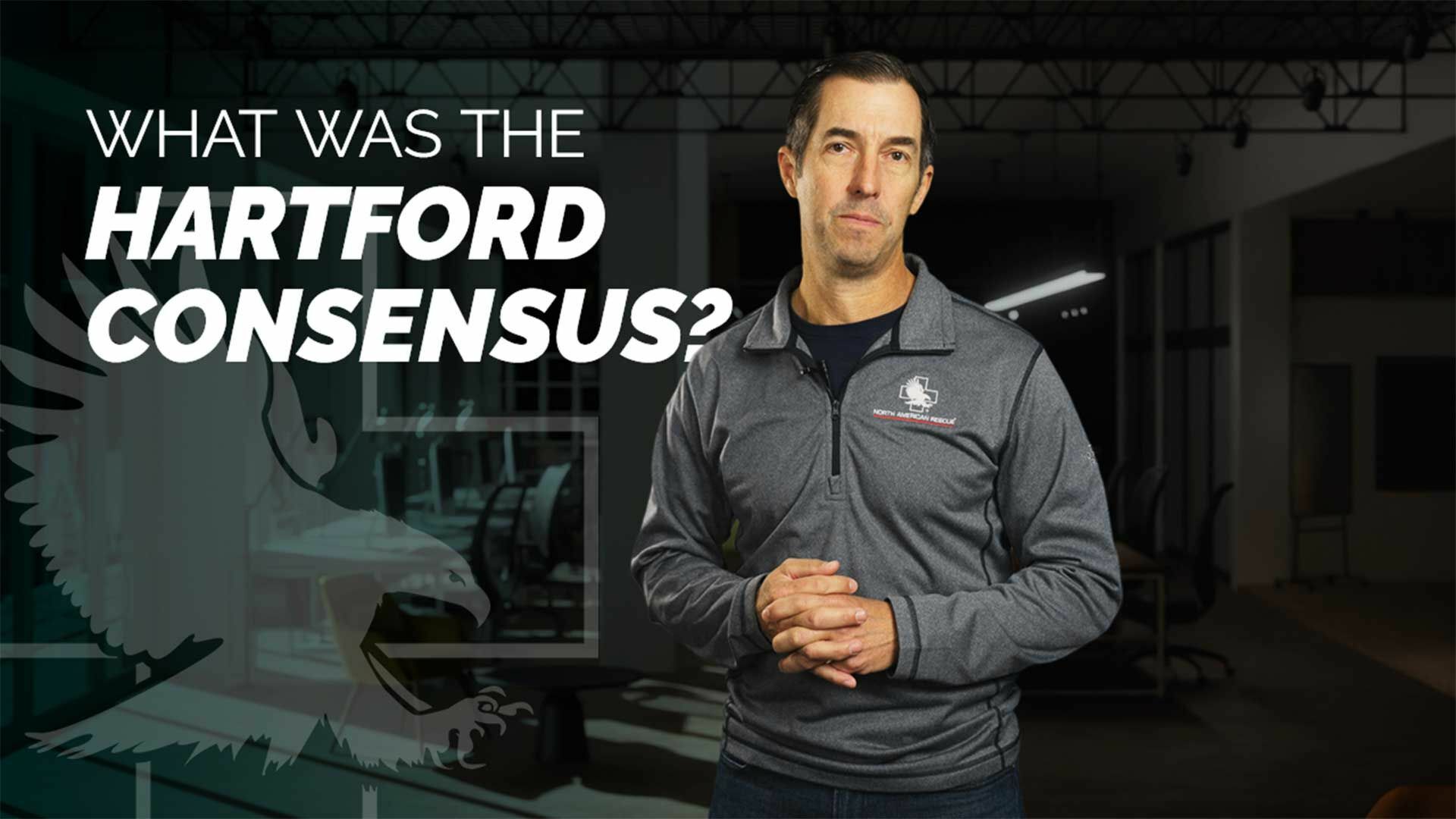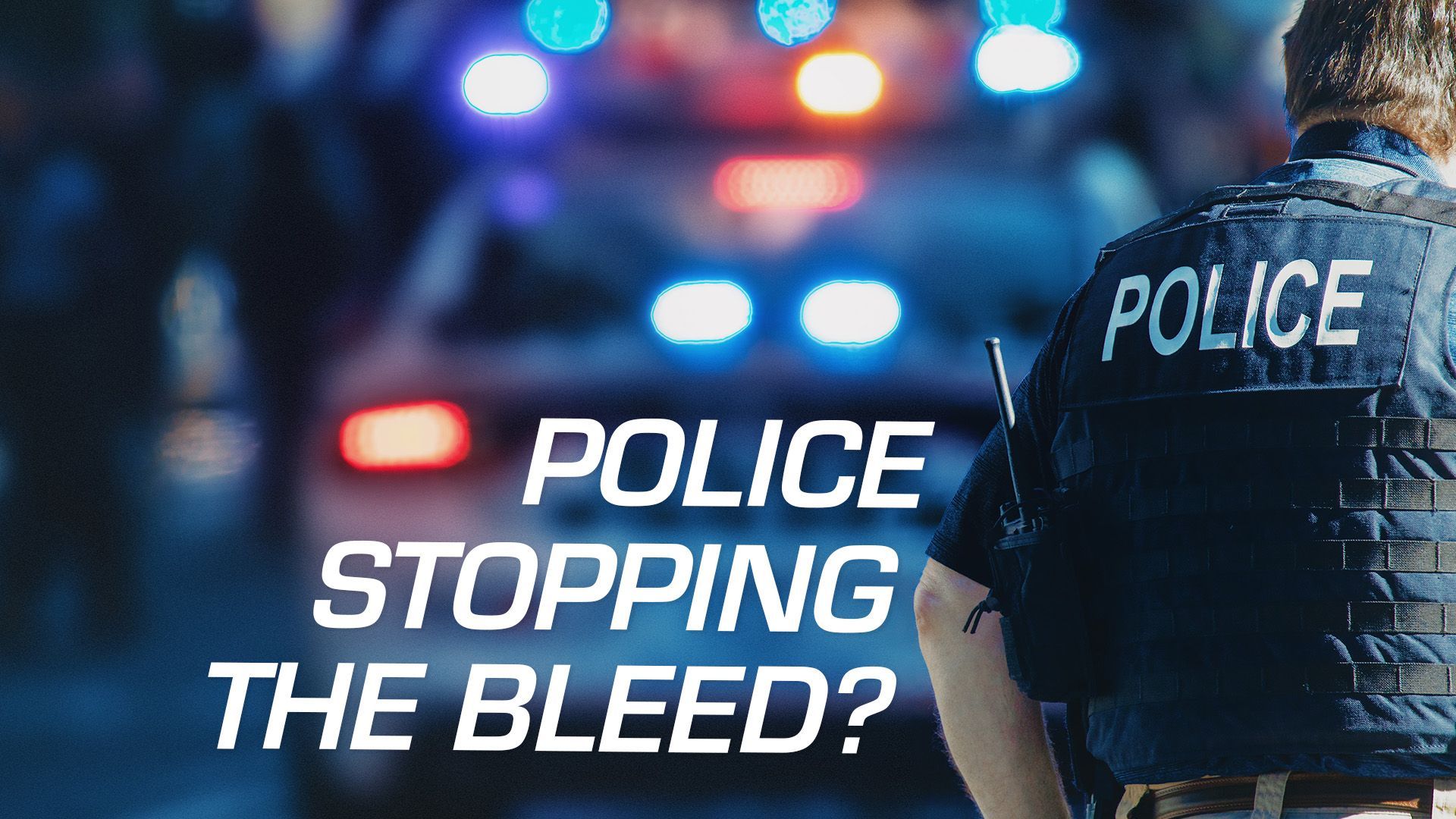What's the Hartford consensus and why does it matter?
Following the horrific events that occurred at Sandy Hook Elementary School, a joint committee was created. Their focus was to enhance survivability in times of mass casualty incidents at home. And really what they did is they got together to look at lessons learned from that incident, tie those together with best practices from the battlefield, from civilian medicine, and see how we can enhance survivability during mass casualty incidents. This became known as the Hartford Consensus and this consists of multiple reports. But really what it did is it gave us a set of guidelines that we can follow in civilian pre-hospital medicine and emergency response for mass casualty incidents so we can prevent death.
One of the things that the committee realized is that waiting for EMS is not the answer when you have people bleeding out.
T.H.R.E.A.T.
The acronym T.H.R.E.A.T. was developed out of this meeting as a way for state, local, EMS, fire, and law enforcement to all take a similar look at casualties during a mass casualty incident or an active shooter incident.
So what does T.H.R.E.A.T. stand for?
Threat Suppression
Hemorrhage Control
Rapid Extraction to Safety
Assessment by medical providers
Transport to definitive care
Threat Suppression
What this acronym does is it gives us a guide for priorities of care during a mass casualty incident. So number one is you want to stop that threat.
Hemorrhage Control
The second thing you want to do once that threat is stopped is you want to stop bleeding. Again, remember, a major bleed, someone can bleed out in as little as two to three minutes. So you need to stop that bleeding as soon as safely possible.
Rapid Extraction to Safety
After that, you want to extract those patients to safety. You want to get them out of harm's way and get them to an area where you can safely treat them.
Assessment by medical providers
Next up, is an assessment by a medical provider. So that's where you have your EMS providers or any of your pre-hospital team that's going to assess.
Transport to definitive care
And then we're going to rapidly get those patients to a hospital as quickly as possible.
Additionally, in Hartford Consensus 1, they all agreed that there should be a system of joint protocols. There should be a shared definition of terms, so all agencies that might respond to an active shooter event are all using the same terms, and similar protocols. And then, most importantly, these need to be rehearsed across agencies. So EMS, law enforcement, federal agencies, fire, everybody needs to rehearse these protocols and what to do in a mass casualty shooter event.
What was the Hartford Consensus 2?
Well, the Hartford Consensus 2 was a set of recommendations made by the committee following the Hartford Consensus 1. This set of recommendations focused on public, law enforcement, and then fire, and EMS. So, for the public, really the core thing that they wanted to push to the public was the concept of run, hide, fight.
Run, Hide, Fight.
The concept of run hide fight means if you’re in an active shooter event, the first thing you should do is run. You should try to get as far away from that threat as possibly can and keep on going. The second one is hide. So if you're not able to run, then you want to hide and get away from that threat and make yourself not an object of that threat. If that doesn't work, then third, what you want to do is fight back and you want to fight back as hard as you can and with everything that you've got.
Law Enforcement
So that was the focus for the public. For law enforcement, the emphasis to law enforcement out of the Hartford Consensus 2 was that every law enforcement officer needs to have the appropriate supplies for hemorrhage control, for external hemorrhage control. So that involves having a tourniquet. Having a hemostatic and a pressure dressing. Every law enforcement officer needs to be trained in these skills. And that needs to be a core skill for every law enforcement officer they're going to be one of the first ones on the scene and one of the first ones to a victim, especially in a hot zone.
Fire, EMS & Rescue Teams
Finally, EMS and fire or rescue teams, It was emphasized that external hemorrhage control should be a primary focus and a core skill in that field. They should be able to properly apply tourniquets, apply hemostatics, pressure dressing, and incorporate a lot of what we do in tactical combat casualty care into the civilian sector. Eventually, that would become tactical emergency casualty care for the civilian sector.
Also, they had a focus on improving the interface between law enforcement, fire, and EMS to join in teams as a casualty response team. Finally, for EMS, fire and rescue, great emphasis was placed on their ability to control external hemorrhage. Using tourniquets to stop extremity hemorrhage, using hemostatic gauze, pressure dressing to control hemorrhage, and recognizing internal hemorrhage so that they can prioritize them for rapid evacuation. And then finally, working together as a team. so that they might integrate better with law enforcement and be prepared to go into warm zones, take care of casualties and be an integrated team rather than a law enforcement team and a separate medical response team.
EMS & Rescue Teams
The third group that the Hartford consensus to looked at was EMS fire and rescue as a combined group. Their recommendations again were that they learn and incorporate hemorrhage control as a core skill. So the use of tourniquets, hemostatics, and pressure dressings as a core skill. Also to recognize internal hemorrhage so that they could prioritize them for rapid evacuation and kind of top of the list for triage.
They also talked about incorporating some of the skills from tactical combat casualty care (TCCC), and the lessons learned from the military into civilian medicine. And then finally they talked about the integration of fire and rescue into the current rescue task force. So this is kind of the early discussions about hot zones, warm zones, and forming a rescue task force to go into the warm zone, get casualties, rapid treatment, and extraction.
What was the Hartford Consensus 3?
The Hartford Consensus 3 was a follow-up committee from the Hartford Consensus that occurred in April 2015. Their focus was on implementation strategies for hemorrhage control. They identified three different levels of responders and what actions they should take.
Immediate Responders
The first level was immediate responders, and that's essentially the person that's right next to the casualty when the shooting occurs, they're also known as bystanders. So when you hear bystander care, that's really what we're talking about is that immediate responder. What they identified is that they're critical in that first step in eliminating preventable death and stopping massive hemorrhage.
What they did is said, “Hey, If you're next to a casualty, you're the most effective person in saving that person's life.” So you need to apply tourniquets, hemostatics, and pressure dressings as quickly as possible to stop the bleeding and stop the dying.
Profesional First Responders
The next level up is professional first responders. So that includes law enforcement, EMS, fire and rescue teams, really law enforcement's primary job is to stop that threat. So once they've stopped that threat, then they should work as a team for initial assessment, bleeding control, and rapid triage and transport. to higher levels of medical care.
Trauma Profesional Responders
Finally, the third level that they had some focus on was trauma professionals and really, their ability to triage these patients and rapidly provide definitive care in the operating room.
Bleeding Control Placement
Another focus of the Hartford Consensus 3 was the placement of bleeding control items. What they recommended is that bleeding control items like tourniquets, hemostatics, and pressure dressing be placed in all public access areas. So, schools, gymnasiums, movie theaters, malls, you name it. Anywhere there's an AED, you should also have a bleeding control station so that these materials are widely accessible to the public in the event of a mass casualty incident.
What was the Hartford consensus 4?
The Hartford Consensus 4 was a follow-up meeting in January of 2016.
This was a call for increased national resilience. The focus of this meeting that they published was, let's focus on bystander training, knowing that if we equip and properly train bystanders, they're more willing to step up, take action, and save lives. Again, the person next to the one injured is most likely to be able to save their life. Again, bleeding, you can bleed out in two, or three minutes, and so you don't always have time to to have EMS respond, come and stop that bleeding for you. It has to be the person next to you.
Equip and Train
The Hartford Consensus called on the public to equip and train. The Hartford Consensus 4 provided strong support for public Stop the Bleed classes. Now, that can be a course like Bleeding Control, an AEMT course, the American College of Surgeons course, or several others out there to include North American Rescue’s, bleeding control course.
So for training, they emphasize the need for the public and first responders to recognize massive bleeding. So things like pulsatile or steady bleeding from the wound, blood pooling on the ground, blood soaking through clothing, bandages becoming soaked with blood, traumatic amputations, or a bleeding patient that is now in shock. Those are the ones we need to step in right away and treat them as appropriate. So initially, we want to provide direct pressure and then we want to employ The tools in the bleeding control kit. So again, tourniquet, hemostatic and pressure dressing.
So the take home really from this is that if you properly train the public to respond and you equip them, they're much more likely to step up, and save a life. So make sure if you're reading this, that you've already done a bleeding control course. If you haven't, make sure you do one. If you haven't, get trained. Then do your part to step up, become an instructor and train everyone that you can.




